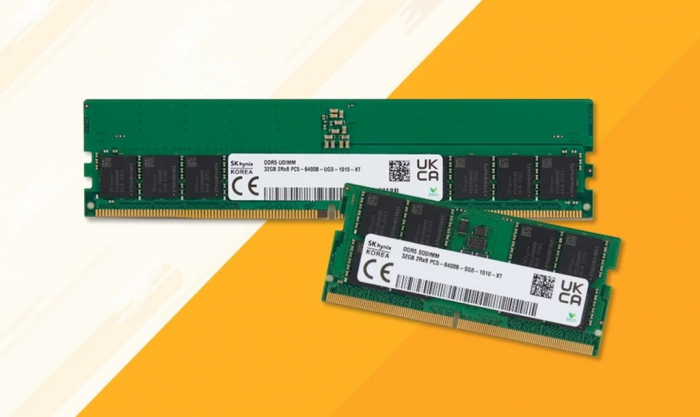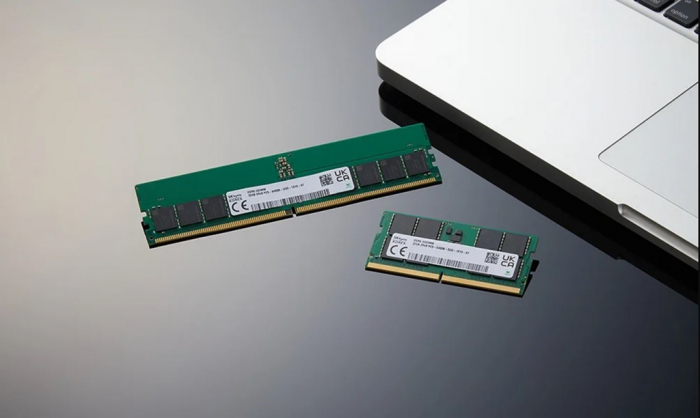Korean chipmakers
SK Hynix eyes DDR5 dominance with industry’s fastest chip modules
With exponential data growth, DDR5 is becoming the new standard, providing support for dropping DRAM prices
By Oct 25, 2022 (Gmt+09:00)
2
Min read
Most Read
LG Chem to sell water filter business to Glenwood PE for $692 million


KT&G eyes overseas M&A after rejecting activist fund's offer


Kyobo Life poised to buy Japan’s SBI Group-owned savings bank


StockX in merger talks with Naver’s online reseller Kream


Meritz backs half of ex-manager’s $210 mn hedge fund



SK Hynix Inc., the world’s second-largest memory chipmaker, is aiming to secure market dominance for a next-generation DRAM chip called DDR5 by offering samples of the industry’s fastest chips to its clients for certification.
The South Korean chipmaker said on Tuesday it has developed 32-gigabyte DDR5 memory modules, UDIMM and SODIMM, which boast the industry’s fastest speed of 6,400 megabits per second, and sent samples to its customers.
UDIMM and SODIMM are memory modules used in desktop PCs and laptops.
At a speed of 6,400 Mbps about 10 full-HD quality movies can be transferred in one second, according to the company.
For a stable operation during high-speed data processing, the company said it has applied a new device called a clock driver, or CKD, to its latest modules.
DDR5, short for double data rate 5, is the next-generation DRAM chip, boasting faster speed and higher density with reduced power consumption compared to DDR4 chips. The latest memory is suitable for data-intensive supercomputing, artificial intelligence and machine learning applications.
DDR4, released in 2013, currently accounts for 90% of the server and PC DRAM market.

FIRST CHIPMAKER TO RELEASE DDR5
SK Hynix, which became the industry’s first chipmaker to release DDR5 DRAM in October 2020, aims to enhance its presence in the growing market.
This summer, the company completed customer certification for its DDR5 module products made with its cutting-edge 1a technology, which applies to fourth-generation 10-nanometer DRAM products.
The key advantage of the 1a technology is that it grants a 25% increase in the number of chips produced using the same-sized wafer, compared with the third generation based on the 1z nanometer node.
With exponential data growth, chipmakers are racing to develop new DDR chips, set to become the new DRAM standard. DDR5 chips are also 20-30% more expensive than DDR4 chips.
Samsung, the world’s largest memory chipmaker, unveiled the industry’s first 512-gigabyte DDR5 module based on High-K Metal Gate (HKMG) process technology in May 2021
In August, Micron Technology Inc. said it is also entering the DDR5 DRAM arena by shipping its DDR5 DRAM to Intel and AMD for server and workstation certification.
According to market research firms, the share of DDR5 chips in the overall DRAM market is forecast to rise to 40% by 2025 from an estimated 20% in 2023.
SK Hynix plans to unveil a fifth-generation 10 nm 1b DDR5 chip using extreme ultraviolet (EUV) technology in the first half of next year.
Write to Sungsu Bae at baebae@hankyung.com
In-Soo Nam edited this article.
More to Read
-
 Korean chipmakersSamsung, Qualcomm unveil industry’s fastest LPDDR5X DRAM chip
Korean chipmakersSamsung, Qualcomm unveil industry’s fastest LPDDR5X DRAM chipOct 18, 2022 (Gmt+09:00)
1 Min read -
 Korean chipmakersMicron’s entry into DDR5 market: A boon for Samsung, SK Hynix
Korean chipmakersMicron’s entry into DDR5 market: A boon for Samsung, SK HynixAug 30, 2022 (Gmt+09:00)
2 Min read -
 Korean chipmakersSK Hynix makes industry’s highest density 24Gb DDR5 DRAM chip
Korean chipmakersSK Hynix makes industry’s highest density 24Gb DDR5 DRAM chipDec 15, 2021 (Gmt+09:00)
2 Min read -
 Korean chipmakersSamsung makes industry’s smallest 14 nm DDR5 chip with EUV technology
Korean chipmakersSamsung makes industry’s smallest 14 nm DDR5 chip with EUV technologyOct 12, 2021 (Gmt+09:00)
4 Min read -
 Korean chipmakersSamsung widens lead over rivals with industry’s first advanced DDR5
Korean chipmakersSamsung widens lead over rivals with industry’s first advanced DDR5Mar 26, 2021 (Gmt+09:00)
3 Min read
Comment 0
LOG IN


